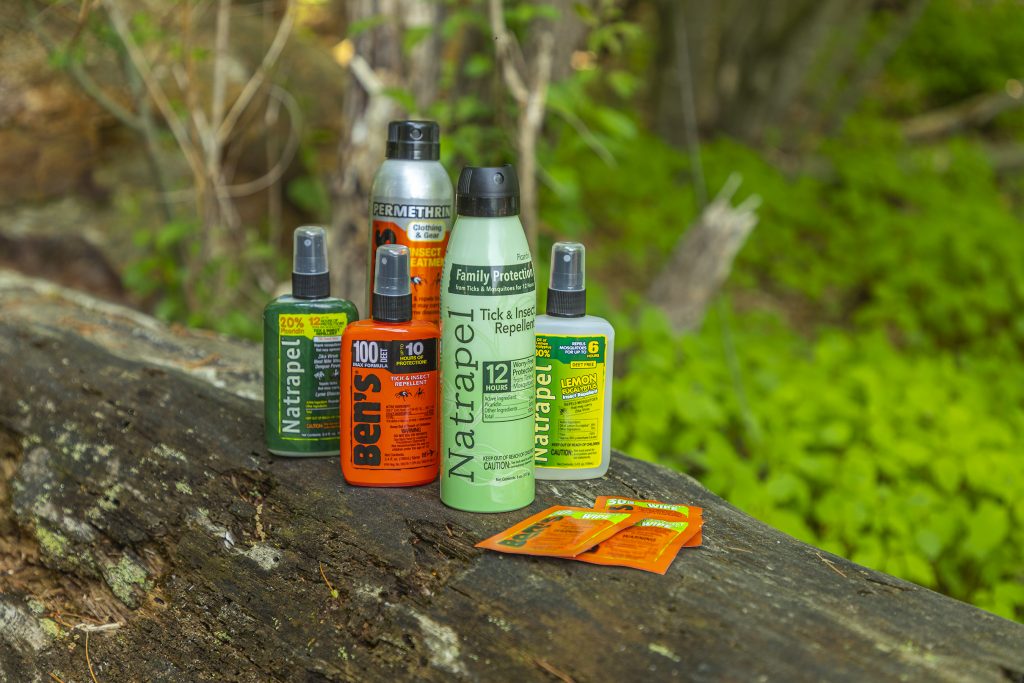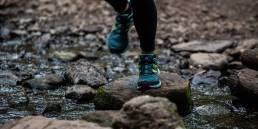The Northeast is known for many things, like its steep trails, unpredictable weather, and picturesque scenery. A lesser-known characteristic of the region is its bugs. Whether trudging up a White Mountain trail, shredding Vermont singletrack, or kicking back at an Adirondack swimming hole, Northeasterners contend with their fair share of pests like mosquitoes, black flies, and ticks. Luckily, bug repellent can help keep them at bay.

What Is Insect Repellent?
Insect repellent is a substance applied to the skin, clothing, or other items to prevent insects from landing or biting. Bug repellents work in a variety of ways, but typically, they work to mask the scent of humans or repel insects with an unpleasant smell or taste. Insect repellents are either chemical based or natural, which share many similarities, but also have their differences.
What Are the Different Kinds of Insect Repellents?
1. DEET
DEET is a popular insect repellent that works very well. It’s used on both skin and clothing and is effective against mosquitoes, ticks, and other biting insects.
PROS:
- Versatile and offers a variety of strengths
- Inexpensive and found in most stores
CONS:
- Can damage clothing and certain fabrics
- Offers short-term protection (needs reapplication for extended protection)
- Toxic to fish; ideally, its use is avoided around water
2. Permethrin
Permethrin is a synthetic compound effective against ticks, mosquitoes, and other biting insects. It’s applied to clothing and outdoor gear, rather than applied directly to the skin.
PROS:
- Easy to apply and requires fewer applications
- Long-lasting option
CONS:
- Requires planning ahead
- Commonly more expensive than other options
- Highly toxic for many animals (for example, cats are particularly sensitive to permethrin)
3. Picaridin
Picaridin is similar to DEET, but less oily and has a duller scent. It’s based on a chemical found in some pepper plants. Picaridin provides maximum protection in concentrations of up to 20% and lasts up to 12 hours before reapplication is necessary. It’s effective against mosquitoes and ticks and is used on skin, clothing, and gear.
PROS:
- Proven equally effective as DEET
- Minimal odor and leaves a less sticky residue on the skin
CONS:
- Toxic to fish and some plants
- Safety hasn’t been studied as extensively as other options
4. Natural Repellents
Natural repellents use only natural ingredients to repel insects, and are more environmentally friendly than chemical-based repellents. Some popular repellents include:
- Citronella Oil is the most well-known natural insect repellent. It’s derived from lemongrass oil and repels mosquitoes and other flying insects.
- Peppermint Oil is effective against mosquitoes and flies. It has a strong scent that is unpleasant to insects in a way that keeps them from biting.
- Lemon Eucalyptus Oil is as effective as DEET as a mosquito repellent. It’s derived from the leaves of the lemon eucalyptus tree.
- Neem Oil is derived from the seeds of the neem tree. It has a bitter taste and its scent is effective at repelling various insects, including mosquitoes, ticks, and fleas.
PROS:
- Chemical free
- Safe on the skin and prevents irritation, rashes, itchiness, or redness
- Available in a variety of products, such as candles, lotions, sprays, soaps, and shampoos
- Safe for children and pregnant women
CONS:
- Generally less effective than other options
- Often more expensive than other options

Five Things to Consider When Choosing Bug Repellent
- Duration of Protection: If you spend an extended period outdoors, choose a repellent with long-lasting protection.
- Broad Spectrum Protection: Choose a repellent that provides broad-spectrum protection against insects, including mosquitoes, ticks, and flies.
- Ease of Use: Consider what type of product would be the most effective and convenient for whatever activity you will be doing.
- Size and Portability: Choose a repellent best suited to your personal needs. For example, if you’re planning a multi-day backpacking trip and need enough repellent to last for multiple days, it’s a smart strategy to spray your gear and clothing before leaving home.
- Environmental Impact: When possible, choose as biodegradable and environmentally friendly products as you can. When applying bug repellent, take care to spray just yourself, your clothes, or your gear—avoiding plants, trees, dirt, and other natural resources.
Other Ways To Protect Yourself
Of course, repellant isn’t the only way to protect yourself from bugs—and it can be a lot more effective when combined with these other strategies.
- Avoid perfumy toiletries and soaps: Steer clear of fragrance-based soaps and toiletries when recreating outdoors.
- Dress appropriately: When possible, wear long pants, long-sleeved shirts, and high socks to avoid mosquito and tick bites.
- Eschew peak times: Mosquitoes are most active just before sunset and after sunrise. If feasible, avoid activities during those hours.
- Choose the location carefully: Avoid mosquitos by staying away from areas where they breed and incubate, such as damp, low-lying places.
Final Thoughts About Bug Repellent
There are numerous options and important factors to consider when choosing an insect repellent that’s right for you. Reading the label and following the instructions carefully before using any repellent is always good. Additionally, be conscious of the active ingredients, the negative environmental impact, and your personal preferences.
Andrea Davis
Andrea is a hiker, writer, and adventurer wandering around New England. She spends most of her time in the White Mountains of New Hampshire. She enjoys snowboarding, snowshoeing, hiking at night, and traveling.




